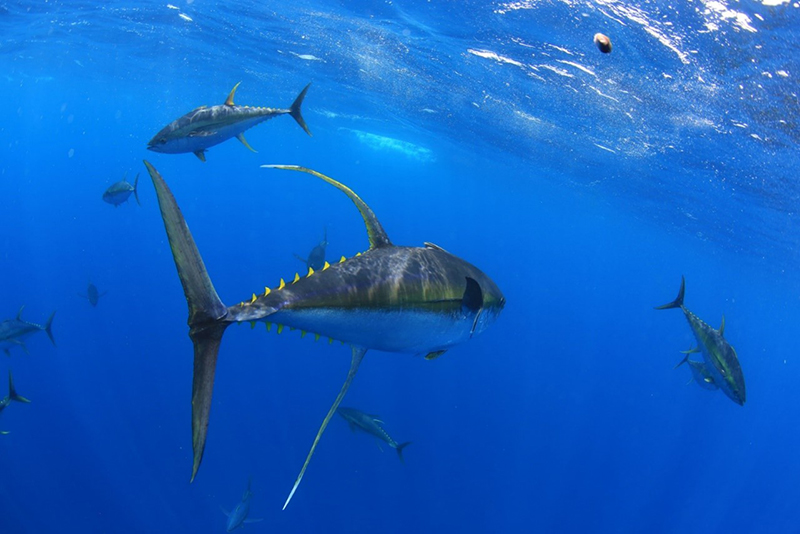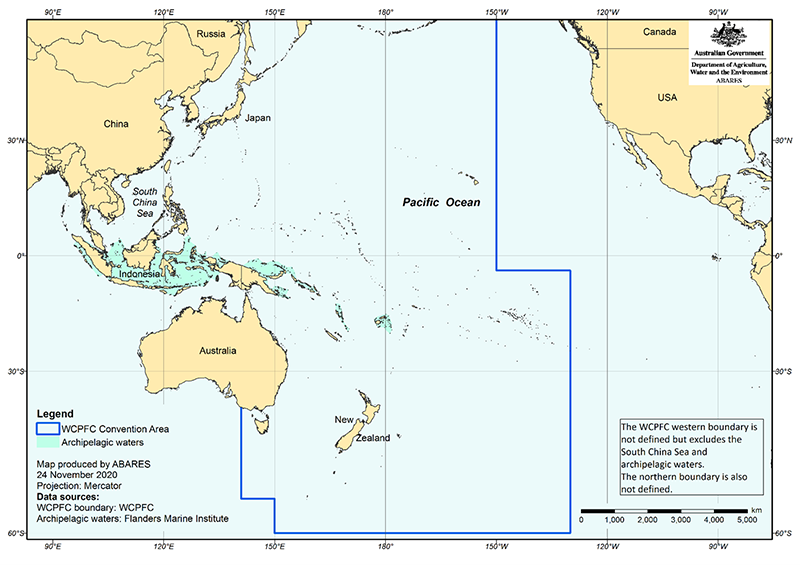The Convention on the Conservation and Management of Highly Migratory Fish Stocks in the Western and Central Pacific Ocean (the Convention) established the Western and Central Pacific Fisheries Commission (WCPFC). The WCPFC is an inter-governmental organisation with the objective to ensure the long-term conservation and sustainable use of highly migratory fish stocks in the Western and Central Pacific Ocean.
WCPFC manages the largest tuna fishery in the world. The total annual catch of tuna in the Western and Central Pacific Ocean represents around 55 per cent of global tuna production. Approximately half of this catch is from the exclusive economic zones (EEZs) of Pacific island countries.
Pacific island countries rely on highly migratory fish stocks for food security and economic prosperity. For many Pacific island populations, 70-90 per cent of animal protein comes from the sea. It is estimated there are over 23,000 jobs related to tuna fisheries in Pacific island countries.
Species
Conservation and management measures are in place to maintain and protect the sustainability of both target and non-target species, including:
- Skipjack tuna (Katsuwonus pelamis)
- Yellowfin tuna (Thunnus albacares)
- Bigeye tuna (Thunnus obesus)
- Pacific bluefin tuna (Thunnus orientalis)
- Albacore (Thunnus alalunga)
- Swordfish (Xiphias gladius)
- Striped marlin (Kajikia audax)
- Sharks
Vessels targeting tuna focus on the warm tropical waters near the equator in the Western Central Pacific Ocean. The majority of fishing occurs between 20° north and 20° south, including within the EEZs of many of the small island countries within the Area. There is a need for close cooperation between the Pacific island countries and other developed countries whose fleets of vessels fish for these stocks. For a full list of species managed by WCPFC visit the WCPFC stock status and advice.
WCPFC Area of Competence
As indicated in the figure above, the Convention Area runs 60° south to 60° north and estimated 125° West to 140° East, covering almost 20 percent of the Earth’s surface. The Convention Area overlaps with two other RFMOs: The Indian Ocean Tuna Commission (IOTC), the Commission for the Conservation of Southern Bluefin Tuna (CCSBT).
Australia’s role and highlights in WCPFC
The WCPFC’s management of highly migratory species includes both the high seas and EEZs of coastal States. As such, WCPFC decisions and conservation measure apply to some Australian fisheries:
- the Eastern Tuna and Billfish Fishery, and
- the Eastern Skipjack Fishery.
The Eastern Tuna and Billfish Fishery is Australia’s fourth most valuable domestic fishery. See more about Australia’s fish stock status (Fishery Status Report).
Australia seeks to improve fisheries management measures across the region. This includes driving the implementation of harvest strategies. This is a natural extension of Australia’s domestic fisheries policy which promotes the use of harvest strategies as a key tool in ensuring the sustainability of its fisheries.
Australia’s engagement in WCPFC is interlinked with our engagement in the Pacific Islands Forum Fisheries Agency (FFA), which operates as a regional capacity development bloc to ensure Pacific island countries maintain effective participation in WCPFC. Given the large number of members and Australia’s relatively small participation in the fishery, constructive engagement within WCPFC and the FFA allows Australia to better protect the particular interests of Australian fishers, including their access to stocks subject to limit controls. Read more on the WCPFC tuna fisheries in the ABARES Fishery Status Reports.
WCPFC history and membership
WCPFC is the result of complex negotiations between FFA members, other coastal States, and distant water fishing nations, and was one of the first regional fisheries agreements to be adopted since the conclusion in 1995 of the UN Fish Stocks Agreement. The Convention opened for signature in 2000.
Australia was a founding member of the WCPFC, which entered into force in June 2004. Members first met as the Commission in December 2004.
There are currently 33 Members and Participating Territories, as well as a number of cooperating non-members.Visit the WCPFC website for more on the history of the WCPFC and a full list of members.
Annual Meetings
Annual meetings of the WCPFC and its subsidiary bodies are held in the second half of the year. See more at WCPFC meetings.


